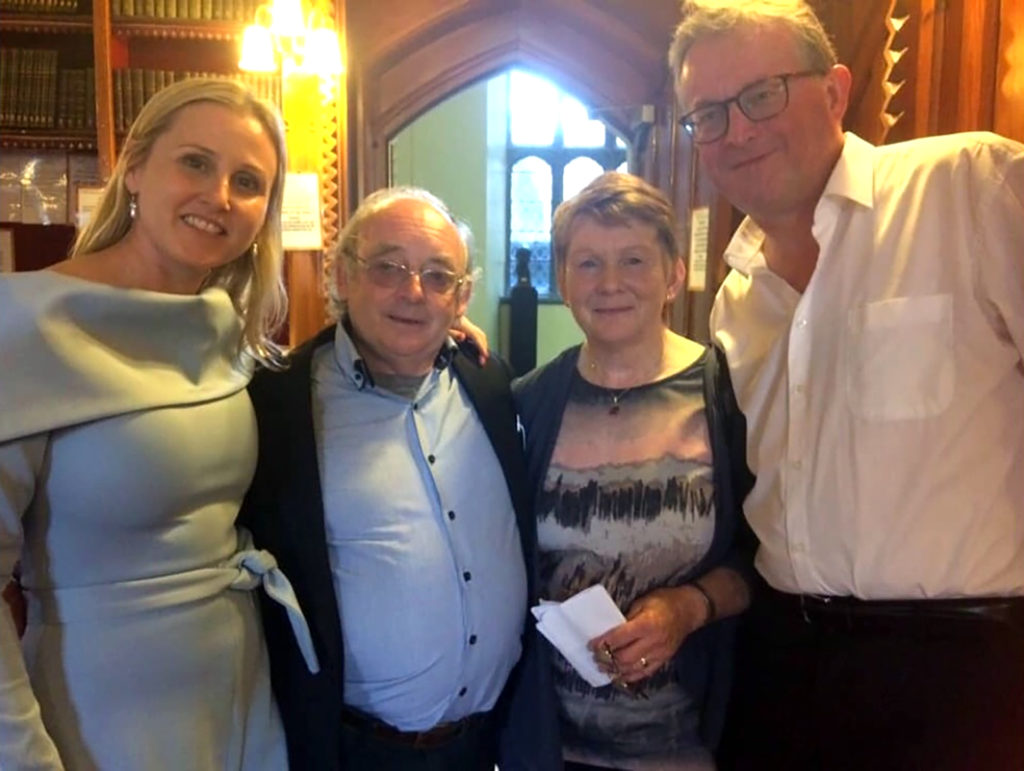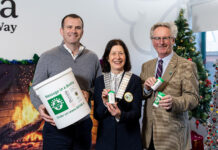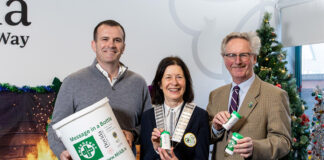by Donal O’Keeffe
“We need to name these babies,” Catherine Corless told me, “so people can know who they were, and how they died.”
I walked the grounds of the old Bessborough mother and baby home on Monday with Catherine Corless and her husband Aidan.
We were trespassing, and we walked onto what was at the time a busy building site, but I find that if you affect a general air of being in charge, you’ll get away with a lot. Ask any priest, nun or brother.
Besides, you’ll seldom know with greater certainty that you have right on your side than when you’re with Catherine Corless on the site of a mother and baby home.
In case you’ve spent the past five years living on Rockall, Catherine Corless is the historian who exposed the Tuam Babies scandal. She came to international prominence in 2014, when her research established that 796 children had died in the Tuam mother-and-baby home.
The Tuam story was broken in the Irish Mail on Sunday by Alison O’Reilly, who had been inspired by Anna Corrigan’s tireless search for her brothers John Desmond Dolan and William Joseph Dolan, two baby boys born in the Tuam Home in 1947 and 1950.

The claim that up to 796 babies might be buried illegally in a disused sewerage treatment system on the grounds of the former home sparked international outrage.
Powerful voices, in this country and further afield, did their best to pour cold water on the story, preferring to see it as an anti-Catholic media conspiracy.
In 2017, archaeological excavations ordered by the Mother and Baby Homes Commission of Investigation found that ‘significant quantities of human remains’ in at least 17 chambers of a 20-chamber underground structure, the purpose of which ‘appears to be related to the treatment/containment of sewage’.
Catherine Corless was in Cork for the launch on Monday night in UCC of the Cork iteration of “Stay With Me”, an art exhibition inspired initially by the Tuam Babies, and honouring all survivors of Magdalene laundries, mother-and-baby homes, industrial schools, and forced adoption.
In April of this year, the fifth interim report of the Mother and Baby Homes Commission of Investigation revealed that more than 900 children died in the religious-run Bessborough mother and baby home in Cork, and the Commission was only able to find burial records for 64 of those children.
On Monday, we walked into the nuns’ graveyard at Bessborough, with construction workers doozering around us as they worked to rebuild the castle folly demolished in March on the orders of the Sisters of the Sacred Hearts of Jesus and Mary.
I told Catherine and Aidan that I genuinely cannot decide whether the nuns ordered the destruction of the castle folly – just as the Commission report was due to land – out of arrogance or out of spite, but that I believe their being ordered by Cork City Council to rebuild it is a small but very sweet victory.
A little later, as we walked the field beyond the nuns’ graveyard, the one marked on one old map ‘Children’s Burial Ground’, I told Catherine and Aidan about Bridget, and her beautiful baby William.
Bridget contacted me five years ago, as the Tuam Babies story raged.
“I had a beautiful baby boy, born in Bessborough in 1960 (who) died at six weeks, (and I was) myself lucky to have survived with the same infection; was told a dirty needle. I hadn’t known where my son was buried until 15 year ago when I plucked up enough courage to confront the nuns at Bessborough.
“I now know.
“Although I was a so-called inmate in Bessborough at the time of his burial, I was not allowed to be at his burial. It breaks my heart not knowing if he was dressed in a gown, or even if he was laid in a coffin.
“To this day, 54 years later, (I am) still trying to come to terms with the horror of it all.
“May God forgive them.
“Bridget. (2014)
William was six weeks old when he died at St Finbarr’s Hospital. Bridget was informed by the nuns of his death and told he had already been buried.
That was a lie.
William would not be buried until after Bridget had left Bessborough, and then, it seems, because he was ‘unclaimed’, he was buried in a pauper’s grave on Carr’s Hill.
Years later, in 1994, Bridget telephoned the nuns at Bessborough, asking – as her daughter Carmel Cantwell puts it – “what her son died from, how old he was when he died, was a priest present at his burial, where was he buried and why was she not told about or allowed to attend her own son’s funeral?”
The nuns made an inquiry to the chaplaincy at St Finbarr’s. A letter was returned advising that William had been buried – ‘unclaimed’ – at Carr’s Hill. The nuns chose not to tell Bridget.
A few months later, Bridget went to Cork, and, she told me she “plucked up enough courage to confront the nuns at Bessborough”.
Carmel says her mother was taken to the nuns’ graveyard but told to stand outside: “Then a nun tapped her foot on the ground in the graveyard and said William was buried right there.”
That was another lie.
“Even then my mother was refused entry into the graveyard so that she could pay her respects to her son at his alleged resting place,” Carmel says. “Her request to place a marker there for her baby was declined.”
A few years later, emboldened by the Tuam Babies story, Bridget and Carmel placed a marker on the spot.
“Beautiful Angel William Gerald Walsh 26-10-1960 – 02-12-1960 My heart burns with my love for you and my soul cries out in sorrow having lost you – Mam xxx”
For Bridget, the idea that William was at rest in what she thought was the angels’ plot in Bessborough, gave her a little peace.
In April of this year, the Commission’s report said: “The Congregation of the Sacred Hearts of Jesus and Mary told the commission that they did not know where the children who died in Bessborough are buried.
“The Commission finds this difficult to comprehend as the Congregation was still providing services to mothers and children right up to the end of the period covered by this investigation” (1922 to 1998).
The Commission describes information provided by the congregation in an affidavit as ‘speculative, inaccurate and misleading’.
Carmel Cantwell found the report particularly hard reading.
“I saw a paragraph where the set of circumstances were very familiar to me. Even though the details were anonymised, I knew the story to be my mother’s and that of her baby, my brother William”.
It was then Carmel realised that her mother’s consolation that William was at rest in Bessborough, was based on a complete fiction.
Poor little William is almost unique among the Bessborough babies in that, lonely and bleak though his burial place is, more than 800 other children are missing completely.
Rumours are whispered around the city, tales of Bessborough mothers, bereft, bribing undertakers so their babies might be encoffined on hallowed ground, secretly buried with the respectable dead, lying at the feet of strangers.
Who can know if those haunted women’s wishes were granted, so easily as their money was taken? Who can know if the stories are true at all?
Catherine Corless told me the other day that she believes the State is in possession of the names of the children who died at Bessborough.
“If the Commission of Investigation can tell us the number of children who died in Bessborough, then it also knows their names, ages and causes of death.
“We need to name these babies, so people can know who they were, and how they died.
“We need to name them, we need to recognise them, and need to honour them.”
The General Register Office, which holds the State’s records of all births, deaths and marriages, comes under the remit of the Department of Employment Affairs and Social Protection.
The details of anyone who was born, died or married in Ireland are freely available to the public and are not covered by the Data Protection Act.
In 2013, Catherine uncovered the names of the 796 children who died in Tuam. She was able to identify the Tuam Babies by their place of death, the Tuam home, or St Mary’s home, Tuam, which operated between 1926 and 1961.
Catherine chose not to release the names of the Tuam Babies herself. However, after Catherine’s work became international news, former Minister for Protection Joan Burton, who is also an adoptee, made the decision to publish the names of the Tuam Babies.
“There is a clear precedent,” Catherine told me.
“If Joan Burton could release the Tuam babies’ names, there would appear to be no reason the Government can’t publish the names of the Bessborough babies, and the names of all of the babies who died in mother-and-baby homes.”
A spokesperson for Minister for Social Protection, Regina Doherty, told me at the weekend that the Minister would do everything in her power to facilitate the publication of the names of the Bessborough children, and to allow interested parties to access the relevant information.
They stopped short of committing that her department would publish the children’s names.
On Monday evening in UCC, Catherine Corless spoke with broadcaster Jonathan Healy. It was a warm and fascinating interview.
“My life was very quiet before the Tuam Babies,” she said.
“This was handed to me, and I have to see it through, no matter who tries to stop me. I was driven on by a force, and I sometimes wonder if that is the spirit of the babies who are still there in the ground.”
She went on to say she had been saddened by the reaction of the Catholic Church.
“I expected the Archbishop to come out – in his own town – and say ‘we’ll help to put this right’. That didn’t happen.”
Tuam business people have missed a golden opportunity, she said, to do right by the Tuam Babies, and to show the world the goodness in the town, preferring instead to wish the scandal would just go away. She wondered too why Cork people aren’t more upset about Bessborough.
“Where are the Cork people in this? There are 900 babies missing in your city. I believe they must be in the grounds of Bessborough. In some ways, it’s worse than Tuam.”
(The Commission of Investigation’s fifth interim report says the Commission ‘considers it highly likely burials took place there’.)
When asked why she thinks the Bessborough nuns haven’t been more helpful to the Commission of Investigation, Catherine said she believed it comes simply down to money.
“I do believe in my heart and soul that it’s down to cost, and what they fear they might lose. Their money. Their land.”
Jonathan Healy then asked if the lack of compassion shown by the institutional Catholic Church had affected Catherine’s faith.
“My faith hasn’t been affected. I still believe in a higher power. I still believe in the beauty of nature. I still believe in the beauty of babies.
“I still believe in the work of God. I don’t need the Church.”
At the weekend, I asked the Mother and Baby Homes Commission of Investigation if it would be publishing the names of the children who died in mother and baby homes.
I was told: “The Commission does not intend to publish the names. In general, Commissions of Investigation are prohibited from disclosing or publishing any evidence given or the contents of any document produced except in very limited circumstances.”
At the time of going to press on Tuesday, the Department of Social Protection had yet to respond to my request that the General Register Office release the Bessborough Babies’ names.
The exhibition ‘Stay With Me’ runs until Friday, 23 August in UCC’s Aula Maxima. Admission is free and all are welcome.








